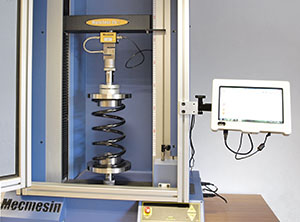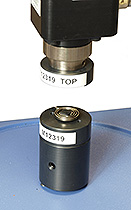 If a spring is consistently to do the job it was designed for, it must, within acceptable tolerances, exert the required force over its range of use, and over extended time in use. Only rigorous testing can ensure this quality, but since springs are so complex and varied, so are the means of testing.
If a spring is consistently to do the job it was designed for, it must, within acceptable tolerances, exert the required force over its range of use, and over extended time in use. Only rigorous testing can ensure this quality, but since springs are so complex and varied, so are the means of testing.
The basic principles remain the same, whether for a watch spring or an aircraft undercarriage spring, but the demands on test equipment are very different. Light springs require very accurate measurement of small forces, with precision movements. At the other extreme, the stiffer the spring, the more rigid a tester must be, so Mecmesin machines incorporate System Deflection Compensation (SDC) in their software. These settings are determined with the required fixtures in place to ensure maximum accuracy.
Spring rate, load at displacement, or displacement at load are important measurements, but not the whole story for spring designers and manufacturers; the whole profile of force and movement needs to be recorded. An exercised spring moves in small complex ways that affect measurement, from the non-linear measurement of a bottoming-out conical spring, to the slight twist or tilt in a helical spring, or the behaviour of an extension spring end loop under tension, and the friction in holding or supporting a light torsion spring as it is worked under test. For accurate and consistent results, systems may therefore require appropriate fixtures that are inflexible, self-levelling, rotate freely, or allow frictionless containment.
 Springs are frequently designed for precise situations, such as torsion springs with legs to engage moving parts, so test fixtures may sometimes need to be made specially, to hold them as they are used. At Mecmesin, we design and manufacture fixtures to requirement.
Springs are frequently designed for precise situations, such as torsion springs with legs to engage moving parts, so test fixtures may sometimes need to be made specially, to hold them as they are used. At Mecmesin, we design and manufacture fixtures to requirement.
Conditioning or scragging a spring before measurement gives a more accurate measurement of its performance in use, so test programs also need to incorporate the ability to do this. Similarly, cycle testing may require the exercising of a spring many times, with measurements perhaps taken at regular intervals.
Mecmesin understands the requirements for not only spring designers but spring users. What counts on a production line or goods-in testing, is rapid and repeatable testing of springs in large batches, and being able to switch between stored test programs quickly for different types of spring. Our touch-screen systems are designed for this. They can be programmed to receive a spring, accurately measure free height or position, before and after conditioning, and measure spring rate at the required forces and displacements, before resetting to receive the next sample, all requiring minimal operator training.
Springs have individual design specifications, derived from materials used, manufacturing method, and finish. These characteristics each have their own industry standard specifications in turn. But the only way to ensure performance to specification is to test in line with standard test methods for springs.